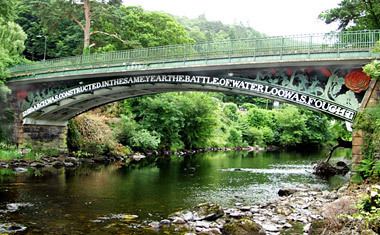No. of spans 1 Material Cast iron | Longest span 32 metres (105 ft) Opened 1815 Bridge type Arch bridge | |
 | ||
Carries Motor vehicles (2 lanes)Pedestrians Similar River Conwy, Llyn Elsi, Betws‑y‑Coed railway station, Glan Conwy railway st, Tal‑y‑Cafn railway station | ||
Waterloo Bridge (Welsh: Pont Waterloo) is an early cast iron bridge, spanning the River Conwy at Betws-y-Coed, in Conwy county borough, north-west Wales.
Map of Waterloo Bridge, Betws-y-Coed LL24 0SG, UK
The bridge is located about half a mile south-east of the village. It was built by the civil engineer Thomas Telford. An inscription on the arch records that it was constructed in the year of the Battle of Waterloo, but although designed and constructed in 1815, its erection was not completed that year. It was raised as part of building the road from London to Holyhead (now the A5). The bridge is made wholly from cast iron (apart from the stone bastions) and was only the seventh such bridge to be built.
In 1923, the bridge’s masonry abutments were refurbished, and its superstructure was strengthened by encasing the inner three ribs in concrete. A 178mm reinforced cantilevered concrete deck was also added, which provided extra space for new footways; the cast iron parapet railings were re-erected on the outside of the new footways.
In 1978, a new 254mm reinforced concrete deck was added and the masonry abutments were also strengthened.
In May 1996, the bridge was Grade I listed.
